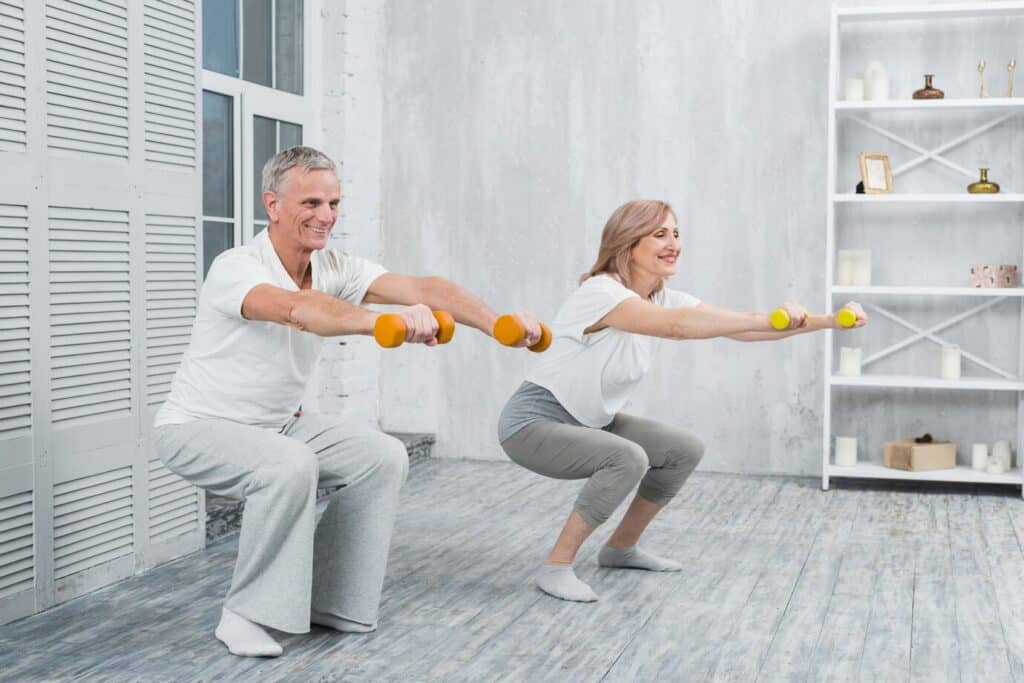Squat Exercise Benefits for Seniors: A Powerful Fitness Tool
Squats are more than just a strength training move – they are a gateway to healthier aging. At Westmont of Cypress, seniors are discovering the squat exercise benefits that go far beyond toned legs. These functional movements engage your muscles, improve mobility, and even protect against injury, all while supporting a more independent lifestyle.
Whether you’re looking to prevent falls, stay limber, or simply enjoy more ease in your daily routine, a squat exercise program can deliver transformative results. With careful guidance and a few smart modifications, squats become accessible to nearly everyone. Let’s explore how incorporating these moves into your weekly regimen can help you thrive.
The Top Squat Exercise Benefits for Seniors
When seniors commit to squats, they’re not just working their legs – they’re investing in a stronger future. Regular squat workouts build strength in the legs and glutes, reinforce core stability, and dramatically improve mobility. Here are some top reasons to include squats in your routine:
- Improved Joint Health: Squats enhance hip and knee flexibility, which is crucial for maintaining independence.
- Boosted Metabolism: By working large muscle groups, squats can help increase calorie burn and support healthy weight management.
- Enhanced Circulation: Movement encourages better blood flow, reducing the risk of varicose veins and promoting cardiovascular health.
Plus, the 10 benefits of squats include better posture, bone density maintenance, and mental focus. Seniors at Westmont of Cypress are finding new strength and vitality thanks to their commitment to fitness. Check out this resource for how we tailor these workouts in our community.
Why Squats Matter for Balance and Fall Prevention
Balance tends to decline with age, but squats offer a practical defense. Strengthening your lower body and core through squats boosts coordination and reduces the chance of falls. For seniors, even mild instability can lead to injury, so prevention is key.
Squat exercise benefits for men and women alike include improved stability and coordination. By regularly practicing squats – particularly squats for seniors like chair squats and wall squats – you reinforce neuromuscular control. These moves train your body to respond to stumbles and imbalances more effectively.
Squats are also ideal for integrating into a home workout plan. This guide dives deeper into senior squat routines that promote safety and strength.
Building Core Strength and Full-Body Mobility
One of the major squat exercise benefits is the way they activate the core. A strong core supports your spine, improves posture, and enhances mobility. You’ll notice daily movements – like getting up from a chair or walking up stairs – become easier and less taxing.
Key advantages of core-enhancing squats include:
- Spinal Alignment: Better core engagement leads to less back pain and fewer posture-related issues.
- Range of Motion: Squats stretch and strengthen joints, supporting smooth, pain-free motion.
- Muscle Symmetry: Working both sides of the body evenly helps prevent muscle imbalances.
Research suggests that squat exercise benefits weight loss by triggering muscle activation that burns calories and builds lean mass. This makes them an efficient, full-body move that complements heart health and weight goals. Learn how regular workouts can reduce the risk of falls and support long-term mobility.
Common Mistakes and Squat Modifications for Seniors
Maintaining correct squat form is essential to avoid injury and get the most out of your workouts. Many beginners unknowingly place strain on their knees or spine, which can lead to setbacks.
To stay safe, follow these tips:
- Keep your knees behind your toes when squatting.
- Engage your core throughout the entire movement.
- Start with supported versions like chair or wall squats.
Explore these chair exercises to start building strength safely and comfortably.
Beginner-Friendly Squat Variations
Adaptations ensure everyone can participate in a squat exercise program, regardless of mobility level:
- Chair Squats: Sit back and rise using controlled motion to improve leg strength.
- Wall Squats: Lean on a wall for support and work on squat depth safely.
- Goblet Squats: Hold a weight close to your chest to boost core activation.
- Bodyweight Squats: Use your body alone to build strength without added stress.
Each variation helps you reach the 10 benefits of squats while prioritizing injury prevention.

Goblet Squats for Superior Form
Goblet squats are a senior-friendly variation that encourages great posture. Holding a dumbbell or water bottle at your chest ensures your upper body remains upright, which minimizes back strain.
Key goblet squat cues:
- Keep your shoulders down and chest lifted.
- Hold the weight firmly to stay balanced.
- Lower slowly, ensuring your knees don’t pass your toes.
This technique maximizes the benefits of squat exercise for men and women and reinforces core strength, improving performance in daily tasks.
Try Bodyweight Squats Anytime, Anywhere
The beauty of bodyweight squats lies in their simplicity. No equipment is needed, and you can do them at home, outside, or even while watching TV.
Advantages:
- No-cost, no-hassle workout option.
- Easy to modify with tempo changes.
- A key piece of any squat exercise program.
They’re also an excellent stepping stone to more challenging moves as you build strength.
Elevate Your Routine with Resistance Band Squats
Looking to level up your squats? Resistance bands add controlled tension, making your muscles work harder. They’re perfect for seniors seeking progression without the risk of heavy lifting.
Benefits include:
- Joint-friendly resistance training.
- Increased muscle engagement.
- Compact and portable for travel or home workouts.
Start light and increase resistance over time. Resistance band squats are a smart way to amplify the squat exercise benefits that weight loss efforts bring.

Get the Most from Your Squat Routine
To fully experience the squat exercise benefits, consistency and variety are essential. Aim to incorporate squats into your fitness routine 2-3 times per week. Mix in different variations and gradually increase intensity.
For seniors, a structured squat exercise program ensures progress while minimizing risk. Try pairing squats with balance drills or light cardio. And always listen to your body – pain is a sign to pause or modify.
Explore how low-impact core exercises can complement your squat journey.
- SilverSneakers: Benefits of Squats for Older Adults
- Harvard Health: Why Strength Training Matters as You Age
Build Strength and Stay Independent with Squats
Incorporating squats into your wellness plan at Westmont of Cypress is a powerful move toward long-term health. From boosting mobility and core strength to helping manage weight, the squat exercise benefits are undeniable.
These simple yet effective moves can change the way you walk, sit, and move through life. So, whether you’re just starting or already on your fitness journey, remember that every squat strengthens your body and your independence.
Ready to learn more? Schedule a tour or call us at 714-252-7144 to explore our vibrant community and wellness programs.
Dive into the vibrant life our Westmont communities have to offer.Find Where You Belong
Frequently Asked Questions
What are the benefits of squat exercise?
Squats are a compound movement that strengthens multiple muscle groups, including the glutes, quads, hamstrings, and core. They improve balance, flexibility, and joint health when performed with proper form. Squats can also enhance athletic performance and support better posture. Over time, they help build lean muscle mass and improve functional movement.
What happens if we do squats every day?
Doing squats daily can lead to increased lower body strength, muscle tone, and endurance. However, without proper rest and variation, it may increase the risk of overuse injuries or muscle fatigue. For best results, combine squats with other exercises and allow recovery time. Listening to your body and adjusting intensity is key to long-term success.
What is the main goal of squats?
The main goal of squats is to build lower body strength and improve core stability. They also aim to enhance mobility and functional fitness, making everyday activities like walking, climbing stairs, or lifting easier. For athletes, squats are crucial for power development and injury prevention. Additionally, they support overall body conditioning when included in a balanced workout routine.
Can squats burn belly fat?
Squats help burn calories and build muscle, which can contribute to overall fat loss, including around the belly. However, they don’t specifically target belly fat, as spot reduction is a myth. Combining squats with a full-body workout and a healthy diet is more effective for reducing belly fat. Consistency in training and nutrition is essential to see visible results.








